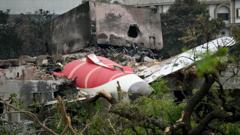In the wake of the Air India Flight 171 crash, a preliminary investigation report has generated a flurry of questions regarding the incident while providing only limited answers. The Boeing 787 Dreamliner tragically went down shortly after departing from Ahmedabad, India, en route to London, resulting in the loss of 241 lives aboard and 19 individuals on the ground. Only one passenger survived the devastating event.
The report, released by India’s Air Accident Investigation Bureau (AAIB), marks the first official account of the crash but stops short of attributing direct blame. Instead, it highlights critical moments leading to the loss of thrust when two fuel cut-off switches were switched from "run" to "cut-off" immediately after take-off. Even though the flight data suggests the engines were restarted after this action, the maneuver occurred too late to avert disaster. The cut-off switches, designed to prevent accidental activation due to their locking mechanism, have raised considerable speculation around potential pilot error.
Furthermore, the report includes a notable exchange between the crew, with one pilot questioning the other about the fuel cut-off, only for the other to deny involvement. However, without a comprehensive transcript or clear identification of the speakers, the investigation leaves vital information unaddressed.
Industry experts have criticized the report for its selective information, with many asserting that significant details surrounding the pilots' actions and the cockpit dialogue are missing. Commentary has emerged suggesting that the lack of a detailed transcript from the cockpit voice recorder clouds clarity regarding what transpired during those crucial seconds.
The Indian Commercial Pilots' Association condemned the immediate speculation that attributes the crash to intentional pilot misconduct, labeling it as a "gross violation of ethical reporting." Such views have coincided with warnings from Air India’s CEO against jumping to premature conclusions, emphasizing the need for patience while the investigation unfolds.
Critics within the aviation sector worry that crucial technical details relating to the engine's behavior before the switches were flipped have not been disclosed, potentially obscuring the true circumstances of the crash. The absence of comprehensive data has prompted speculation that investigators may be withholding information.
Adding to the report's controversy was a reference to an FAA safety bulletin from 2018, warning of potential issues related to fuel cut-off switches, with the implication that Air India had neglected necessary inspections. Although the FAA communicated that the reported issue did not compromise safety, it has nonetheless fed into the narrative of the accident's causation.
Overall, while the preliminary report establishes some parameters surrounding the incident, its vagueness has led to frustration among industry professionals eager for clarity. As the process of investigation continues, a final report is required to emerge within one year, yet historically, such inquiries often extend beyond this timeline—a reality that leaves many searching for answers regarding the Air India Flight 171 disaster.


















